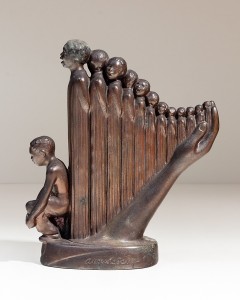Sculptor Augusta Savage Said Her Legacy Was The Work Of Her Students
ArtandSeek.net July 15, 2019 32
Augusta Savage was an artist, educator, activist and community leader. Her work is the focus of an exhibition at the New-York Historical Society, organized by the Cummer Museum of Art & Gardens. She’s pictured above with her 1938 sculpture Realization. Photo: New-York Historical Society
Sculptor Augusta Savage once said: “I was a Leap Year baby, and it seems to me that I have been leaping ever since.” Born on Feb. 29, 1892, Savage leapt from the Jim Crow South to public attention in the Harlem Renaissance but is little known today. Now, her work is the focus of an exhibition at the New-York Historical Society, curated by Jeffreen M. Hayes and coordinated for the historical society by Wendy N.E. Ikemoto.
Savage grew up in Green Cove Springs, a brick-making town in Florida. “It had all of this natural red clay, and so Savage would seek out those red clay pits as a child,” explains Ikemoto. But before long, “she stopped making mud pies and started making things.”

Savage’s 1942 terracotta Portrait of a Baby recalls the small, red clay sculptures she made as a child.
Photo: New-York Historical Society
Savage’s father — a fundamentalist minister — disapproved. He viewed his daughter’s little clay figures as graven images and punished her for them. Savage later recalled her father beating her several times a week; “He nearly whipped all the art out of me,” she said.
But a teacher spotted the girl’s talent and encouraged her. Eventually, with $4.60 cents in her pocket, she moved to Harlem, cleaned houses to pay her rent, and studied at The Cooper Union School of Art.
At 30, she got a scholarship to the Fontainebleau School of the Arts in Paris. But when the American selection committee found out she was black, they rescinded the offer, fearing objections from Southern white women. The reasoning was the white women “would feel uncomfortable sharing accommodations on the ship, sharing a studio, sharing living spaces,” Ikemoto explains. “And the way that these committee members expressed that decision and the justification for it — they were concerned about Savage. It would be uncomfortable for her.”

Savage modeled Gamin on her nephew, Ellis Ford. It is made of painted plaster. New-York Historical Society
Savage got to Paris anyway. She spent three years there — studying, working, exhibiting, and winning awards.
During the Depression, Savage returned to Harlem and turned her studio into a school, where she gave free art lessons. Jacob Lawrence — noted painter of the great African American migration north — was one of her students. The school was an early step in her lifetime of social activism. Blending activism and art became her mission.
Savage’s 1929 sculpture Gamin, shows a child in a soft cap and wrinkled shirt. Bronze was too expensive, so instead Savage made her sculpture with white plaster covered with brown paint mixed with shoe polish. “What’s so remarkable about this work is that, quite simply, it presented an African American child in a realistic and humane fashion,” Ikemoto says. Thousands of kids came to see Gamin on exhibit, and “they saw themselves as fine art.”

A souvenir version of Savage’s 1939 sculpture The Harp, which was inspired by “Lift Every Voice and Sing.”
Throughout the 1930s, Savage sculpted portrait busts of African American leaders, including NAACP leader James Weldon Johnson, who wrote the lyrics of the anthem “Lift Every Voice and Sing.” When the 1939 New York World’s Fair commissioned Savage to make a sculpture she produced a monumental work called Lift Every Voice and Sing. World’s Fair officials changed the name to The Harp.
“The strings of the harp are formed by the folds of choir robes worn by 12 African American singers,” Ikemoto explains. “Then, the soundboard of the harp is formed by the hand of God.” The singers, then, become instruments of God. Five million visitors saw The Harp and it became one of the Fair’s most photographed objects — you can see photos of it here. Sixteen feet high, made of painted plaster, Ikemoto says it was destroyed — smashed by clean-up bulldozers — at the end of the fair.
Savage, who died in 1962, said that her lasting “monument” would be the artwork of the young people she taught. But you can see her work in the New-York Historical Society’s retrospective, on view through July 28.











